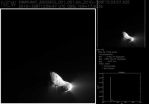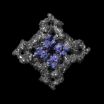(Press-News.org) Which are the best pieces of pork, what their texture is, how moist they are – the secrets pigs keep from even the most skilled butchers – are about to be revealed, thanks to a sophisticated new technique that has been developed by McGill University researchers in conjunction with Agriculture Canada and the pork industry. "This is about giving industry workers better tools to do their job," explained Dr. Michael Ngadi of McGill's Department of Bioresource Engineering. "Computer-aided analysis of meat will result in higher-quality jobs, optimal production, and exports that fit more closely with the target markets."
The technology involves spectroscopy, a technique based on the analysis of the wavelengths of visible and invisible light produced by matter. By measuring the wavelengths of reflected light that pork cuts release, the researchers discovered they could easily determine the colour, texture and exudation (water release) of the meat. The technique is revolutionary, as previous laboratory techniques had involved destroying the testing sample. "The technique enables production workers to conduct objective and scientific analysis of the meat very quickly on the production line," Dr. Ngadi said. It means the meat can be more accurately sorted according to the quality demanded by different export markets.
The research is not far from leaving the laboratory and entering factories, according to Dr. Ngadi. "We are currently looking for partners who will work with us to build a ready-to-use device for a commercial production line," he said. The researchers are also looking to extend the technique for the evaluation of other aspects of meat quality, such as marbling and fat content.
INFORMATION:
This study was part of a project supported by funding from the Natural Science and Engineering Council of Canada and le Fonds québécois de la recherche sur la nature et les technologies.
Pigs reveal secrets: New research shines light on Quebec industry
McGill scientists develop technique to evaluate meat cuts by the light waves they emit
2010-11-05
ELSE PRESS RELEASES FROM THIS DATE:
Hard work improves the taste of food, Johns Hopkins study shows
2010-11-05
It's commonly accepted that we appreciate something more if we have to work hard to get it, and a Johns Hopkins University study bears that out, at least when it comes to food.
The study seems to suggest that hard work can even enhance our appreciation for fare we might not favor, such as the low-fat, low calorie variety. At least in theory, this means that if we had to navigate an obstacle course to get to a plate of baby carrots, we might come to prefer those crunchy crudités over the sweet, gooey Snickers bars or Peanut M&Ms more easily accessible via the office vending ...
Burning pain and itching governed by same nerve cells
2010-11-05
There are disorders and conditions that entail increased itching and can be extremely troublesome for those suffering from it. The mechanisms behind itching are not well understood today. For one thing, what is it about scratching that relieves itching?
In the current study, which was performed on mice, the research team led by Professor Klas Kullander at the Department of Neuroscience examined the nerve cells that transfer heat pain. When these nerve cells had lost its capacity to signal, the mice reacted less to heat, as expected, but surprisingly they also started ...
UMD-led deep impact spacecraft successfully flies by comet Hartley 2
2010-11-05
COLLEGE PARK, Md. – The University of Maryland-led EPOXI mission successfully flew by comet Hartley 2 at 10 a.m. EDT today, and the spacecraft has begun returning images. Hartley 2 is the fifth comet nucleus visited by any spacecraft and the second one visited by the Deep Impact spacecraft.
Scientists and mission controllers are studying never-before-seen images of Hartley 2 appearing on their computer terminal screens. See images at: http://epoxi.umd.edu/
"We are all holding our breath to see what discoveries await us in the observations near closest approach," said ...
Researchers unlock the secret of bacteria's immune system
2010-11-05
Quebec City, November 4, 2010—A team of Université Laval and Danisco researchers has just unlocked the secret of bacteria's immune system. The details of the discovery, which may eventually make it possible to prevent certain bacteria from developing resistance to antibiotics, are presented in today's issue of the scientific journal Nature.
The team led by Professor Sylvain Moineau of Université Laval's Department of Biochemistry, Microbiology, and Bioinformatics showed that this mechanism, called CRISPR/Cas, works by selecting foreign DNA segments and inserting them ...
A 'brand' new world: Attachment runs thicker than money
2010-11-05
Can you forge an emotional bond with a brand so strong that, if forced to buy a competitor's product, you suffer separation anxiety? According to a new study from the USC Marshall School of Business, the answer is yes. In fact, that bond can be strong enough that consumers are willing to sacrifice time, money, energy and reputation to maintain their attachment to that brand.
"Brand Attachment and Brand Attitude Strength: Conceptual and Empirical Differentiation of Two Critical Brand Equity Drivers," a study published in the November issue of the Journal of Marketing, ...
X-rays offer first detailed look at hotspots for calcium-related disease
2010-11-05
Menlo Park, Calif.—Calcium regulates many critical processes within the body, including muscle contraction, the heartbeat, and the release of hormones. But too much calcium can be a bad thing. In excess, it can lead to a host of diseases, such as severe muscle weakness, a fatal reaction to anesthesia or sudden cardiac death.
Now, using intense X-rays from the Stanford Synchrotron Radiation Lightsource (SSRL) at the Department of Energy's SLAC National Accelerator Laboratory, researchers have determined the detailed structure of a key part of the ryanodine receptor, a ...
Colonic navigation
2010-11-05
Nanoparticles could help smuggle drugs into the gut, according to a study published this month in the International Journal of Nanotechnology.
There are several drugs that would have more beneficial therapeutic effects if they could be targeted at absorption by the lower intestine. However, in order to target the colon for treating colon cancer for instance, medication delivered by mouth must surmount several barriers including stomach acidity, binding to mucus layers, rapid clearance from the gut, and premature uptake by cells higher up the gastrointestinal tract. Being ...
Helical CT scans reduce lung cancer mortality by 20 percent compared to chest X-rays
2010-11-05
PROVIDENCE, R.I. [Brown University] — In a major new study announced today by the National Cancer Institute, researchers including Brown University biostatistian Constantine Gatsonis and his colleagues found that screening for lung cancer using helical CT scanning reduced lung cancer deaths by 20 percent compared to using chest X-rays.
"The findings we're announcing today offer the first definitive evidence for the effectiveness of helical CT screening smokers for lung cancer " said Gatsonis, a lead biostatistician in the study and director of the American College of ...
Motor Neurone Disease Association study identifies MND biomarker
2010-11-05
A study funded by the Motor Neurone Disease (MND) Association, in collaboration with the Medical Research Council (MRC), has identified a common signature of nerve damage in the brains of MND patients.
The study's exciting findings have been published in the prestigious journal Neurology (2 November 2010). These are the first results to be published from the ongoing Oxford Study for Biomarkers in MND/ALS (BioMOx).
MND research is being held back by the lack of an early diagnostic test and predictable markers of the progression of the disease – biomarkers. Patients ...
The mind uses syntax to interpret actions
2010-11-05
Most people are familiar with the concept that sentences have syntax. A verb, a subject, and an object come together in predictable patterns. But actions have syntax, too; when we watch someone else do something, we assemble their actions to mean something, according to a new study published in Psychological Science, a journal of the Association for Psychological Science.
"There are oceans and oceans of work on how we understand languages and how we interpret the things other people say," says Matthew Botvinick of Princeton University, who cowrote the paper with his ...
LAST 30 PRESS RELEASES:
Injectable breast ‘implant’ offers alternative to traditional surgeries
Neuroscientists devise formulas to measure multilingualism
New prostate cancer trial seeks to reduce toxicity without sacrificing efficacy
Geometry shapes life
A CRISPR screen reveals many previously unrecognized genes required for brain development and a new neurodevelopmental disorder
Hot flush treatment has anti-breast cancer activity, study finds
Securing AI systems against growing cybersecurity threats
Longest observation of an active solar region
Why nail-biting, procrastination and other self-sabotaging behaviors are rooted in survival instincts
Regional variations in mechanical properties of porcine leptomeninges
Artificial empathy in therapy and healthcare: advancements in interpersonal interaction technologies
Why some brains switch gears more efficiently than others
UVA’s Jundong Li wins ICDM’S 2025 Tao Li Award for data mining, machine learning
UVA’s low-power, high-performance computer power player Mircea Stan earns National Academy of Inventors fellowship
Not playing by the rules: USU researcher explores filamentous algae dynamics in rivers
Do our body clocks influence our risk of dementia?
Anthropologists offer new evidence of bipedalism in long-debated fossil discovery
Safer receipt paper from wood
Dosage-sensitive genes suggest no whole-genome duplications in ancestral angiosperm
First ancient human herpesvirus genomes document their deep history with humans
Why Some Bacteria Survive Antibiotics and How to Stop Them - New study reveals that bacteria can survive antibiotic treatment through two fundamentally different “shutdown modes”
UCLA study links scar healing to dangerous placenta condition
CHANGE-seq-BE finds off-target changes in the genome from base editors
The Journal of Nuclear Medicine Ahead-of-Print Tip Sheet: January 2, 2026
Delayed or absent first dose of measles, mumps, and rubella vaccination
Trends in US preterm birth rates by household income and race and ethnicity
Study identifies potential biomarker linked to progression and brain inflammation in multiple sclerosis
Many mothers in Norway do not show up for postnatal check-ups
Researchers want to find out why quick clay is so unstable
Superradiant spins show teamwork at the quantum scale
[Press-News.org] Pigs reveal secrets: New research shines light on Quebec industryMcGill scientists develop technique to evaluate meat cuts by the light waves they emit


